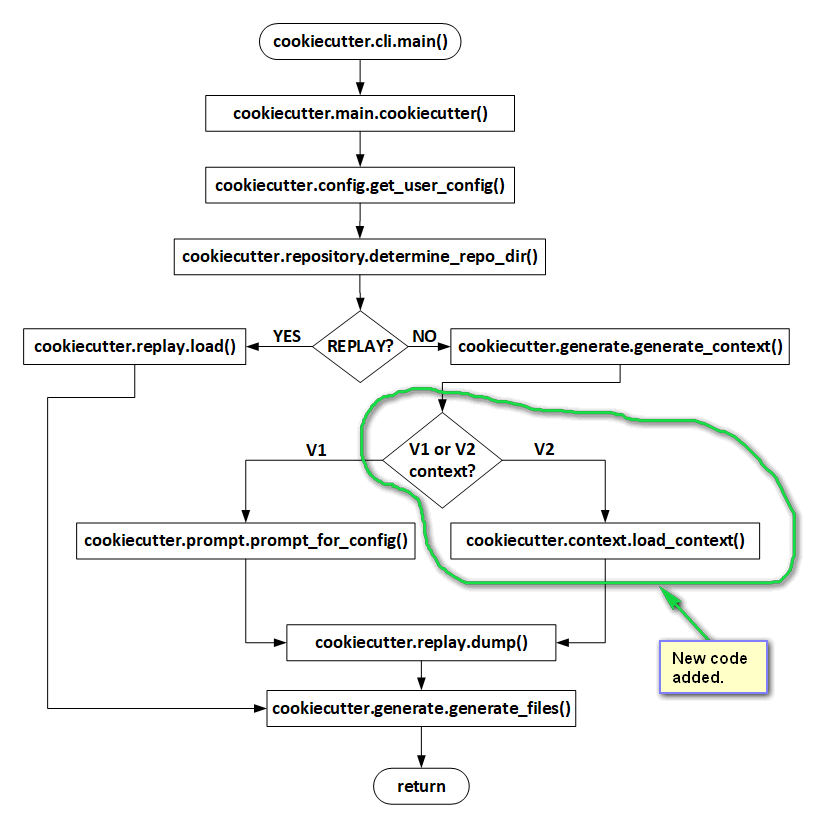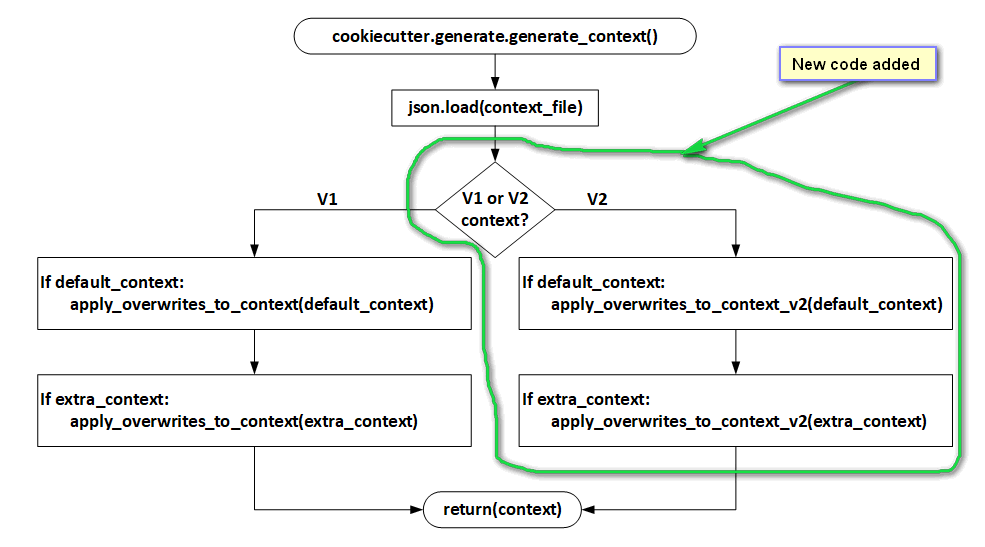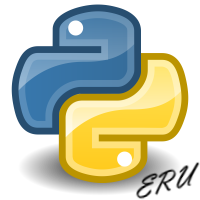The Implementation¶
Before implementation began a general survey of the Cookiecutter v1.6.0 codebase was performed and a set of implementation goals were developed to help shape any implementation decisions that might have to be made.
Implementation Goals¶
The line in the sand here is that Cookiecutter v1.6.0 is compatible with the current cookiecutter.json context format – lets call that context version v1; and Cookiecutter v2 adds additional support for the new cookiecutter.json context format as initially defined by hackebrot’s cookiecutter pull request #848 – lets call that context v2.
The following goals served to guide the implementation of v2 context support:
- Cookiecutter v2.0.0 supports both context v1 and context v2 formats.
- Disturb as little of the existing v1.6.0 codebase as possible - this implementation is not a re-write, or re-factoring of the code that is already in place for v1.6.0; but a graft of support for v2 context onto the v1.6.0 codebase.
- The Cookiecutter user interface does not change.
- Cookiecutter’s external package dependencies do not change.
- Use the context module code referenced by hackebrot’s cookiecutter pull request #848 and located in the new-context-format branch of this hackebrot repo.
- All existing tests for v1 context (Cookiecutter 1.6.0) still pass as originally written when a v1 context is provided via the cookiecutter.json file – in other words, there is no contamination of the 1.6.0 codebase by any v2 changes.
- The new code paths and features implemented that support context v2 have tests that follow the testing structure already defined for v1.6.0; and of course, these new tests achieve 100% code coverage of any new code paths.
Implementation Overview¶
In keeping with Implementation Goal #2 (disturb little) only two source files were updated.
The first being cookiecutter/main.py as shown in the diagram below:

The second source file updated was cookiecutter/generate.py as shown in the diagram below:

The only new source file added to the project was cookiecutter/context.py which implements the v2 context support. This is the code referenced in Implementation Goal #5 above.
The actual repo containing the original version of context.py is located located in the new-context-format branch of this hackebrot repo.
Implementation Statistics¶
Comparing statement coverage reports between Cookiecutter v1.6.0 and v2.0.0 provides us with some indication of how much code was added to the v1.6.0 codebase (a total of 222 statements)
v1.6.0 v2.0.0 Delta Delta
File Name Stmts Stmts Stmts % Notes
---------------------------------------------------------------------------
cookiecutter\__init__.py 2 2 0 0% <-- version bump
cookiecutter\__main__.py 3 3 0
cookiecutter\cli.py 49 49 0
cookiecutter\config.py 51 51 0
cookiecutter\context.py - 163 +163 +100% <-- v2 new context
cookiecutter\environment.py 21 21 0
cookiecutter\exceptions.py 24 24 0
cookiecutter\extensions.py 9 9 0
cookiecutter\find.py 18 18 0
cookiecutter\generate.py 166 222 +56 +33.7% <-- v2 overwrites
cookiecutter\hooks.py 61 61 0
cookiecutter\log.py 21 21 0
cookiecutter\main.py 31 34 +3 +9.7% <-- v2 context load
cookiecutter\prompt.py 90 90 0
cookiecutter\replay.py 30 30 0
cookiecutter\repository.py 39 39 0
cookiecutter\utils.py 50 50 0
cookiecutter\vcs.py 54 54 0
cookiecutter\zipfile.py 61 61 0
---------------------------------------------------------------------------
Stmt Totals 780 1002 222 +28.5%
As you can see from the table above, aside from the version bump, only two original v1.6.0 files were modified and only one new file was added.
Modified Files¶
This section provides a bit more detail on what changes were made to the files modified:
cookiecutter/__init__.py (version bump no further details given herein)
cookiecutter/main.py
cookiecutter/generate.py
cookiecutter/main.py¶
The cookiecutter/context.py file contains a function that determines if a given context is v1 or v2 – this function is called in main.py to differentiate between processing the original v1 context via a call to prompt.prompt_for_config() or calling context.load_context() to process the new v2 context.
cookiecutter/generate.py¶
The changes made to cookiecutter/generate.py all have to do with supporting default and extra context overwrites for version 2 templates.
Added generate.apply_default_overwrites_to_context_v2() to mirror for v2 context what generate.apply_overwrites_to_context() does for v1 context.
Also added generate.apply_overwrites_to_context_v2() to handle v2 context overwrites via the extra context.
Modifed generate.generate_context() to check for v1 or v2 context and call the previously mentioned v2 overwrite functions.
Overwrite Considerations Regarding ‘default’ & ‘choices’ Fields¶
When a variable is defined that has both the ‘default’ and the ‘choices’ fields, these two fields influence each other. If one of these fields is updated, but not the other field, then the other field will be automatically updated by the overwrite logic.
If both fields are updated, then the ‘default’ value will be moved to the first location of the ‘choices’ field if it exists elsewhere in the list; if default value is not in the list, it will be added to the first location in the choices list. The overwrite logic will take care of this even though the extra context choices list does not explicitly specify this behavior.
Special Overwrite Syntax¶
A couple of special syntax tokens were introduced in the extra context processing contained in generate.apply_overwrites_to_context_v2() that allow the following overwrite capabilities:
- Change ‘name’ field in a variable
- Remove a field from a variable
Changing the ‘name’ Field in a Variable
Because the algorithm chosen to find a variable’s dictionary entry in the variables list of OrderDicts uses the variable’s ‘name’ field; it could not be used to simultaneously hold a new ‘name’ field value.
Therefore the following extra context dictionary entry snytax was introduced to allow the ‘name’ field of a variable to be changed:
{
'name': 'CURRENT_VARIABLE_NAME::NEW_VARIABLE_NAME',
}
The variable’s current name is post-fixed with a double colon (::) followed by the new name of the variable.
So, for example, to change a variable’s ‘name’ field from ‘director_credit’ to ‘producer_credit’, would require:
{
'name': 'director_credit::producer_credit',
}
Removing a Field from a Variable
It is possible that a previous extra context overwrite requires that a subsequent variable entry be removed.
In order to accomplish this a remove field token is used in the extra context as follows:
{
'name': 'director_cut',
'skip_if': '<<REMOVE::FIELD>>',
}
In the example above, the extra context overwrite results in the variable named ‘director_cut’ having it’s ‘skip_if’ field removed.
New Files¶
The only new file added to the implementation is:
cookiecutter/context.py
cookiecutter/context.py¶
This file takes care of processing the new v2 context – the base code in this file was written by @hackebrot and available at the new-context-format branch of this hackebrot repo and is referenced and discussed heavily in hackebrot’s cookiecutter pull request #848.
The following features were added to the base code:
- added support for float type since click.prompt supports that type
- added support for UUID type since click.prompt supports that type
- added context v2 check function – used in main.py & generate.py
- type checking on context field injection (inbound data from the JSON file)
- implemented validation of variable’s default or user input value
- added validation flags to allow controlling the validation – ignoring case, etc
- added docstring comments to document parameters for classes Variable and CookiecutterTemplate
- added docstring comments to document parameters for function load_context()
- insured CLI option –no-input also suppresses v2 context user prompts
- added method Variable.__str__() to help with debugging
Implementation TODOs¶
The following sections attempt to document what additional implementation features could be realized in the future.
The Cookiecutter Command Line¶
Add a dump context option that emits the context variable list, but does not render any project files.
I actually have implemented this is a stand-alone command line tool, after implementing it, I realized it would be trivial to just add a flag option to the cookiecutter CLI to do this. But this was not implemented herein because it would violate Implementation Goal #3.
cookiecutter/context.py¶
Could add a CookiecutterTemplate.__str__() that uses the Variable.__str__() to realize a complete string dump of the CookecutterTemplate object for debugging. This would be very easy to do.
A better specification of what differentiates a v1 context from a v2 context should be considered in the future. Right now a v2 context must define the following fields:
name cookiecutter_version variables
At the very least, we could verify that ‘variables’ is a list of OrderedDict objects. But at the moment, we just check for the existence of the three fields.
Perhaps adding a variable field named include of type click.File that specifies a path to a file that can be included/injected into the template. Potential file formats supported could be JSON, INI, YAML, TOML, etc. The idea here being that the file contents could be loaded (included) in the context namespace – includes should probably be done prior to any of the current context processing. This would allow the context namespace to be aware of the contents of other configuration files in the project. Of course this whole idea borders on making Cookiecutter a compiler of configuration files which in and of itself is probably too heavy of a lift.
Documentation Updates¶
Documentation that has been updated:
- The API documentation has been updated
Documentation that has not yet been updated (mostly because of a desire for some concensus moving forward with the user docs):
- The user manual portion of the docs has not been updated, but has been reviewed and the best approach I think would be to add a new third tutorial covering the version 2 template format. Also any place in the user docs where a version 1 format is shown, we could add the analogous version 2 format as well.
- If this pull request gains momentum, and a concensus is reached on what approach is best for the user docs, I will be happy to do the initial implementation.
